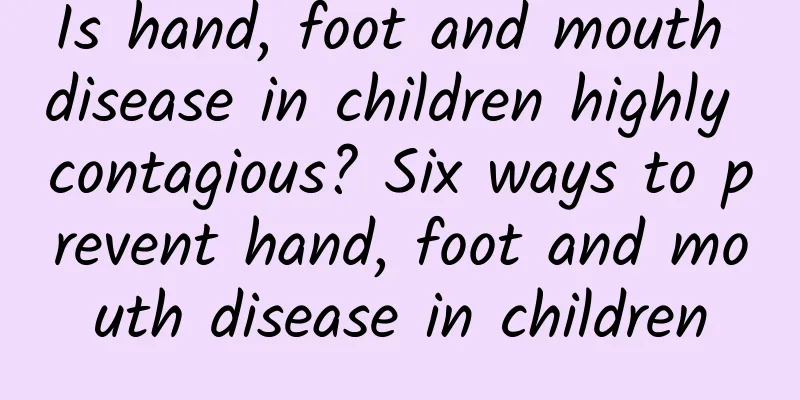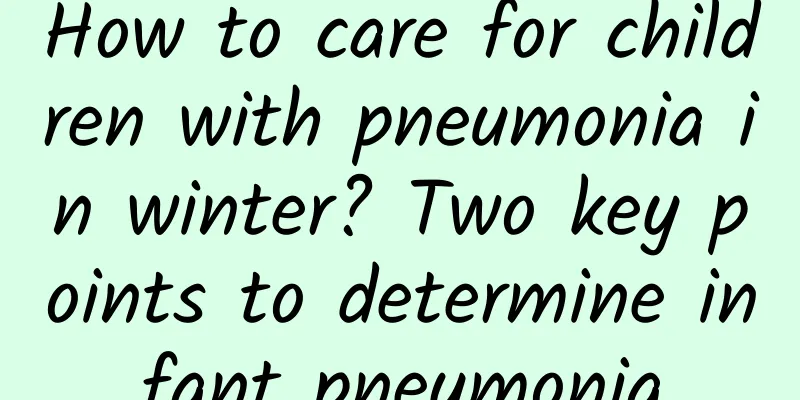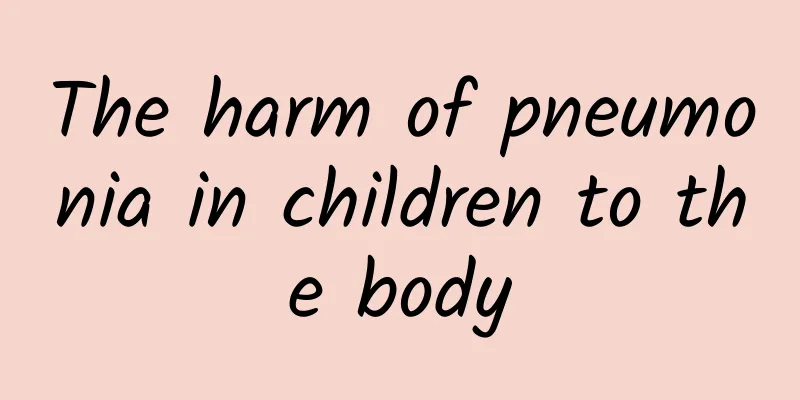Is hand, foot and mouth disease in children highly contagious? Six ways to prevent hand, foot and mouth disease in children

|
Many parents today are worried about the hand, foot and mouth disease that is prevalent this season, and are concerned about their children's growth and health! So, how can we prevent hand, foot and mouth disease? Although there is no vaccine for hand, foot and mouth disease, you can take the following measures to prevent it: 1. Wash your hands frequently, maintain good environmental, food and personal hygiene, and prevent diseases from entering your body through your mouth. 2. Hand, foot and mouth disease often occurs in places where infants and young children gather. Therefore, childcare institutions, schools and other units should conduct morning inspections, promptly identify suspected patients, and isolate and treat them in a timely manner. 3. Contaminated food, daily necessities, tableware, toys, bedding, toilets and other items should be disinfected in a timely manner, clothes should be exposed to the sun, and the room should be kept ventilated. 4. The main measure to prevent hand, foot and mouth disease is to properly handle the patient's feces and other excrement to cut off the transmission route. 5. During the epidemic, parents should try to keep their children away from crowded public places to reduce the chance of infection. 6. During the epidemic period, you can check your child’s skin (mainly the palms and soles of the feet) and oral cavity every morning to see if there are any abnormalities, and pay attention to changes in your child’s body temperature. Hand, foot and mouth disease is a common infectious disease that mainly affects infants and young children. It can be caused by a variety of enteroviruses, including EV71. It usually occurs throughout the year, with a peak period from May to July. Recognizing Hand, Foot and Mouth Disease Symptoms 1. Hand, foot and mouth disease usually has no obvious early symptoms. Most patients will develop the disease suddenly, and the fever is usually around 38°C. 2. Some people may experience symptoms such as coughing, runny nose, loss of appetite, nausea, vomiting, and headache. 3. The rash that appears on the hands, feet, oral mucosa and buttocks of young children is usually painless, non-itchy, and does not form scabs or scars. Since oral ulcers are painful when eating, children often drool and refuse to eat. The rash usually disappears on its own within a week, and the body temperature also drops. Most cases have a good prognosis without sequelae. 4. Very few cases may be accompanied by more serious complications, such as pulmonary edema, aseptic meningitis, flaccid paralysis, myocarditis, etc. Most of these sick children have a persistent high fever and the disease progresses rapidly. It is more common in children under 2 years old. Serious complications such as the central nervous system, respiratory system, and circulatory system often appear within 3 to 5 days after the onset of the disease. If the following symptoms occur, it is likely to be severe hand, foot and mouth disease, and parents should send their children to the hospital for treatment in time. (1) Persistent high fever after the onset of hand, foot and mouth symptoms. (2) The child is irritable and cries, is unwilling to drink milk or water, and has a bad complexion. (3) Lethargy, poor spirits, and even convulsions. Also accompanied by unsteady walking or frequent falls. It is important to actively prevent hand, foot and mouth disease in daily life. After the disease occurs, you can also try traditional Chinese medicine treatment. So, how does traditional Chinese medicine treat hand, foot and mouth disease in children? Honeysuckle 30g, Forsythia suspensa 30g, Chrysanthemum 30g, Mulberry leaf 20g, Mint (added later) 15g, Bupleurum 10g, Phragmites australis 20g, Licorice 15g, Scutellaria baicalensis 15g, Cicada shell 15g, Gypsum (fried first) 20-30g, Talc 20-30g. Function: Clearing away heat and detoxifying, pungent and cool in nature. Indications: It can be used for influenza, viral infection, high fever or low fever. For children, reduce the dosage as appropriate. Explanation of the prescription: Honeysuckle and Forsythia suspensa clear away heat and detoxify, peppermint and bupleurum induce sweating and relieve exterior symptoms, clear away external evil, cicada shell dispels wind and heat, calms the nerves and relieves spasms, mulberry leaves clear the lung meridians, clear away wind-heat, chrysanthemum improves eyesight and dispels wind, clears and lowers lung fire, reed root and licorice clear wind-heat in the upper Jiao and nourishes stomach yin, gypsum clears heat from the yangming meridian without damaging yin, talc opens the orifices, clears heat and relieves muscles, and has a sweating effect, scutellaria clears qi and relieves heat, honeysuckle has a broad antibacterial spectrum, Forsythia suspensa has a significant inhibitory effect on many viruses, so the patient's evil heat can be eliminated through sweating and defecation, thereby eliminating the evil and curing the disease. This prescription was formulated by Professor Liu Shaoxun of Shenyang Institute of Traditional Chinese Medicine based on Yinqiao Powder, Sangju Yin, Liuyi Powder and Baihu Decoction after many years of clinical experience. It was first published in the book "The First Batch of National-level Famous Traditional Chinese Medicine Powder's Effective Secret Prescriptions". I have used it many times and it is effective for influenza, viral infections, high fever and low fever. According to the antibacterial test report, Honeysuckle and Forsythia suspensa have obvious inhibitory effects on many bacteria and viruses! Antibiotics are used in everyone's treatment. This disease is a viral disease, and the indications for using antibiotics should be strictly controlled. |
<<: What are the causes of tics and what are the treatments for tics?
Recommend
How to treat itchy red bumps on children's bodies How to treat itchy red bumps on children's bodies
Children have poor resistance because their bodie...
Exercise can treat ADHD in children
In fact, the treatment of ADHD in children requir...
What are the symptoms of polio?
Polio is a very terrible disease and an acute inf...
How to treat breast milk jaundice? Some tips on the treatment of breast milk jaundice
Breast milk jaundice is a very common jaundice. W...
What should we be careful about in children with acute laryngitis?
Generally speaking, the incidence of acute laryng...
How to treat eczema in children
Pediatric eczema can be treated with topical medi...
How long after dinner is it best to drink milk? It is best to drink milk one hour before going to bed
Milk should be a common drink in most families at...
What to do if your baby is deficient in calcium and zinc
If your baby is often picky about food, he or she...
How to easily identify indigestion in children and how to check indigestion in children
Children's health is a concern, and parents a...
How many days does hand, foot and mouth disease usually take to heal?
Generally speaking, mild patients can recover wit...
What is neonatal persistent cholestatic jaundice? Analysis of the causes of neonatal jaundice
(I) Causes of the disease There are many causes o...
It is not difficult to treat physiological jaundice in children. Experts will give you some advice.
Physiological jaundice in children is a common ph...
Are antibiotics effective in treating pneumonia in children? Is it necessary to keep the indoor air fresh for children with pneumonia?
Now that autumn and winter have arrived, children...
How to prevent colds in children in autumn 4 tips to effectively prevent colds in children in summer and autumn
The weather is cool and hot at the turn of summer...
Is it possible to have a baby if you have orchitis due to mumps?
Orchitis, a complication of mumps, may affect fer...









